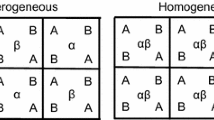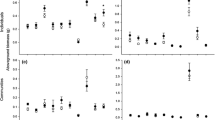Abstract
Recent applications of coexistence theory to plant invasions posit that non-natives establish in resident communities through either niche differences or traits conferring them with fitness advantages, the former being associated with coexistence and the latter with dominance and competitive exclusion. Plant–soil feedback is a mechanism that is known to explain both coexistence and dominance. In a system where natives and non-natives appear to coexist, we explored how plant–soil feedbacks affect the performance of nine native and nine non-native ruderal species—the prevalent life-history strategy among non-natives—when grown alone and with a phytometer. We also conducted field samplings to estimate the abundance of the 18 species, and related feedbacks to abundances. We found that groups of native and non-native ruderals displayed similar frequencies of negative, positive, and neutral feedbacks, resulting in no detectable differences between natives and non-natives. Likewise, the phytometer exerted comparable negative impacts on native and non-native plants, which were unchanged by plant–soil feedbacks. Finally, feedbacks explained plant abundances only after removing one influential species which exhibited strong positive feedbacks but low abundance. Importantly, however, four out of five species with negative feedbacks were rare in the field. These findings suggest that soil feedbacks and plant–plant interactions do not confer an advantage to non-native over native species, but do contribute to the observed coexistence of these groups in the system. By comparing natives and non-natives with overlapping abundances and strategies, our work broadens understanding of the consequences of plant–soil feedbacks in plant invasion and, more generally, coexistence within plant communities.



Similar content being viewed by others
References
Adler PB, HilleRisLambers J, Levine JM (2007) A niche for neutrality. Ecol Lett 10:95–104
Agrawal AA, Kotanen PM (2003) Herbivores and the success of exotic plants: a phylogentically controlled experiment. Ecol Lett 6:712–715
Agrawal AA, Kotanen PM, Mitchell CS, Power AG, Godsoe W, Klironomos JN (2005) Enemy release? An experiment with congeneric plant pairs and diverse above and belowground enemies. Ecology 86:2979–2989
Andonian K, Hierro JL (2011) Species interactions contribute to the success of a global invasive weed. Biol Invasions 13:2957–2965
Andonian K, Hierro JL, Khetsuriani L, Becerra P, Villarreal D, Janoian G, Fox LR, Callaway RM (2011) Range-expanding populations of a globally introduced weed experience negative plant–soil feedbacks. PLoS One 6(5):e20117
Andonian K, Hierro JL, Khetsuriani L, Becerra P, Janoian G, Villareal D, Cavieres L, Fox LR, Callaway RM (2012) Geographic mosaics of plant–soil microbe interactions in a global plant invasion. J Biogeogr 39:600–608
Annapurna D, Rathore TS, Joshi G (2004) Effect of container type and size on the growth and quality of seedlings of Indian sandalwood (Santalum album L.). Austral For 67:82–87
Armas C, Ordiales R, Pugnaire FI (2004) Measuring plant Interactions: a new comparative index. Ecology 85:2682–2686
Baker HG (1974) The evolution of weeds. Annu Rev Ecol Evol Syst 5:1–24
Bever JD (1994) Feeback between plants and their soil communities in an old field community. Ecology 75:1965–1977
Bever JD (2003) Soil community feedback and the coexistence of competitors: conceptual frameworks and empirical tests. New Phytol 157:465–473
Bever JD, Westover KM, Antonovics J (1997) Incorporating the soil community into plant population dynamics: the utility of the feedback approach. J Ecol 85:561–573
Blaney CS, Kotanen PM (2001) Effects of fungal pathogens on seeds of native and exotic plants: a test using congeneric pairs. J Appl Ecol 38:1104–1113
Brinkman EP, van der Putten WH, Bakker EJ, Verhoeven KJF (2010) Plant-soil feedback: experimental approaches, statistical analyses and ecological interpretations. J Ecol 98:1063–1073
Cabrera AL (1994) Regiones fitogeográficas argentinas. Primera reimpresión. Acme, Buenos Aires (in Spanish)
Callaway RM (2007) Positive interactions and interdependence in plant communities. Springer, Dordrecht
Callaway RM, Thelen GC, Rodriguez A, Holben WE (2004) Soil biota and exotic plant invasion. Nature 427:731–733
Cano E, Fernández B, Montes MA (1980) Inventario integrado de los recursos naturales de la provincia de La Pampa. UNLPam, Gobierno de la provincia de La Pampa e INTA, Buenos Aires (in Spanish)
Caplan JS, Yeakley JA (2013) Functional morphology underlies performance differences among invasive and non-invasive ruderal Rubus species. Oecologia 173:363–374
Carvalho LM, Antunes PM, Martins-Loucao MA, Klironomos JN (2010) Disturbance influences the outcome of plant–soil biota interactions in the invasive Acacia longifolia and in native species. Oikos 119:1172–1180
Casper BB, Castelli JP (2007) Evaluating plant–soil feedback together with competition in a serpentine grassland. Ecol Lett 10:394–400
Chesson P (2000) Mechanisms of maintenance of species diversity. Annu Rev Ecol Evol Syst 31:343–366
Cook RD (1977) Detection of influential observations in linear regression. Technometrics 19:15–18
Crawley MJ (2005) Statistics: an introduction using R. Wiley, New York
Diez JM, Dickie I, Edwards G, Hulme PE, Sullivan JJ, Duncan RP (2010) Negative soil feedbacks accumulate over time for non-native plant species. Ecol Lett 13:803–809
Dukes JS (2002) Species composition and diversity affect grassland susceptibility and response to invasion. Ecol Appl 12:602–617
Engelkes T, Morriën E, Verhoeven KJF, Bezemer TM, Biere A, Harvey JA, McIntyre LM, Tamis WLM, van der Putten WH (2008) Successful range-expanding plants experience less above-ground and below-ground enemy impact. Nature 456:946–948
Eppinga MB, Rietkerk M, Dekker SC, De Ruiter PC (2006) Accumulation of local pathogens: a new hypothesis to explain a exotic plant invasions. Oikos 114:168–176
Godoy O, Levine JM (2014) Phenology effects on invasion success: insights from coupling field experiments to coexistence theory. Ecology 95:726–736
Grime JP (1974) Vegetation classification by reference to strategies. Nature 250:26–31
Grman E, Suding KN (2010) Within-year soil legacies contribute to strong priority effects of exotics on native California grassland communities. Restor Ecol 18:664–670
Harnden J, MacDougall AS, Sikes BA (2013) Field-based effects of allelopathy in invaded tallgrass prairie. Botany 89:227–234
Hierro JL, Maron JL, Callaway RM (2005) A biogeographical approach to plant invasions: the importance of studying exotics in their introduced and native range. J Ecol 93:5–15
Hierro JL, Villarreal D, Eren Ö, Graham J, Callaway RM (2006) Disturbance facilitates invasions: the effects are stronger abroad than at home. Am Nat 168:144–156
Hierro JL, Lortie CJ, Villarreal D, Estanga-Mollica ME, Callaway RM (2011) Resistance to Centaurea solstitialis from annual and perennial grasses in California and Argentina. Biol Invasions 13:2249–2259
HilleRisLambers J, Adler PB, Harpole WS, Levine JM, Mayfield MM (2012) Rethinking community assembly through the lens of coexistence theory. Annu Rev Ecol Evol Syst 43:227–248
Keane RM, Crawley MJ (2002) Exotic plant invasions and the enemy release hypothesis. Trends Ecol Evol 17:164–170
Klironomos JK (2002) Feedback with soil biota contributes to plant rarity and invasiveness in communities. Nature 417:67–70
Kulmatiski A, Beard KH, Stevens JR, Cobbold SM (2008) Plant–soil feedbacks: a meta-analytical review. Ecol Lett 11:980–992
Kulmatiski A, Heavilin J, Beard KH (2011) Testing predictions of a three-species plant–soil feedback model. J Ecol 99:542–550
Levine JM, HilleRisLambers J (2009) The importance of niches for the maintenance of species diversity. Nat 461:254–257
Levine JM, Adler PB, Yelenik SG (2004) A meta-analysis of biotic resistance to exotic plant invasions. Ecol Lett 7:975–989
Levine JM, Pachepsky E, Kendall BE, Yelenik SG, HilleRisLambers J (2006) Plant–soil feedbacks and invasive spread. Ecol Lett 9:1005–1014
MacDougall AS, Gilbert B, Levine JM (2009) Plant invasions and the niche. J Ecol 97:609–615
MacDougall AS, Rillig MC, Klironomos JN (2011) Weak conspecific feedbacks and exotic dominance in a species-rich savanna. Proc R Soc B 278:2939–2945
Mack RN, Simberloff D, Lonsdale WM, Evans H, Clout M, Bazzaz FA (2000) Biotic invasions: causes, epidemiology, global consequences, and control. Ecol Appl 10:689–710
Mackey JML, Neal AM (1993) Harvesting, recording, weight, area and length. In: Hendrey GAF, Grime JP (eds) Methods in comparative ecology. Chapman & Hall, London, pp 24–25
Meisner A, de Deyn GB, de Boer W, van der Putten WH (2013) Soil biotic legacy effects of extreme weather events influence plant invasiveness. Proc Natl Acad Sci USA 110:9835–9838
Mitchell CE, Power AG (2003) Release of invasive plants from fungal and viral pathogens. Nature 421:625–627
Parepa M, Schaffner U, Bossdorf O (2013) Help from under ground: soil biota facilitate knotweed invasion. Ecosphere 4:1–11
Pearson DE, Hierro JL, Chiuffo MC, Villarreal D (2014a) Rodent seed predation as a biotic filter influencing exotic plant abundance and distribution. Biol Invasions 16:1185–1196
Pearson DE, Icasatti NS, Hierro JL, Bird BJ (2014b) Are local filters blind to provenance? Ant seed predation suppresses exotic plants more than natives. PLoS One 9(8):e103824
Perkins LB, Nowak RS (2012) Soil conditioning and plant-soil feedbacks affect competitive relationships between native and invasive grasses. Plant Ecol 213:1337–1344
Perkins LB, Nowak RS (2013) Native and non-native grasses generate common types of plant–soil feedbacks by altering soil nutrients and microbial communities. Oikos 122:199–208
Petermann J, Fergus AJF, Turnbull LA, Schmidt B (2008) Janzen–Connell effects are widespread and strong enough to maintain diversity in grasslands. Ecology 89:2399–2406
Prieto A (2000) Vegetational history of the Late glacial-Holocene transition in the grasslands of eastern Argentina. Palaeo 157:167–188
Reinhart KO (2012) The organization of plant communities: negative plant–soil feedbacks and semiarid grasslands. Ecology 93:2377–2385
Reinhart KO, Callaway RM (2006) Soil biota and invasive plants. New Phytol 170:445–457
Rúgolo de Agrasar ZE, Steibel PE, Troiani HO (2005) Manual ilustrado de las gramíneas de la provincia de La Pampa. UNLPam-UNRC, Santa Rosa
Shannon S, Flory SL, Reynolds H (2010) Competitive context alters plant–soil feedback in an experimental woodland community. Oecologia 169:235–243
Shea K, Chesson P (2002) Community ecology theory as a framework for biological invasions. Trends Ecol Evol 17:170–176
Suazo AA, Spencer JE, Engel EC, Abella S (2012) Response of native and non-native Mojave Desert winter annuals to soil disturbance and water additions. Biol Invasions 14:215–227
Suding KN, Harpole WS, Fukami T, Kulmatiski A, MacDougall AS, Stein C, van der Putten WH (2013) Consequences of plant–soil feedbacks in invasion. J Ecol 101:298–308
Tilman D (1982) Resource competition and community structure. Princeton University Press, Princeton
Troiani H, Steibel P (2008) Reconocimiento de malezas: Región subhúmeda y semiárida pampeana. Universidad Nacional de La Pampa, Colegio de Ingenieros Agrónomos de La Pampa, Santa Rosa
van der Putten WH, Peters BAM (1997) How soil-borne pathogens may affect plant competition. Ecology 78:1785–1795
van der Putten WH, Bardgett RD, Bever JD, Bezemer M, Casper BB, Fukami T, Kardol P, Klironomos JN, Kulmatiski A, Schweitzer JA, Suding KN, van der Voorde TFJ, Wardle DA (2013) Plant–soil feedbacks: the past, the present and future challenges. J Ecol 101:265–276
van Grunsven RHA, van der Putten WH, Bezemer TM, Tamis WLM, Berendse F, Veenendaal EM (2007) Reduced plant–soil feedback of plant species expanding their range as compared to natives. J Ecol 95:1050–1057
Veen GF, de Vries S, Bakker ES, van der Putten WH, Olff H (2014) Grazing-induced changes in plant–soil feedback alter plant biomass allocation. Oikos 123:800–806
Wainwright CE, Cleland EE (2013) Exotic species display greater germination plasticity and higher germination rates than native species across multiple cues. Biol Invasions 15:2253–2264
Wolfe BE, Klironomos JN (2005) Breaking new ground: soil communities and exotic plant invasion. Biosci 55:477–487
Zar JH (2003) Biostatistical analysis. Pearson Education Inc., Delhi
Acknowledgments
We are grateful for the assistance provided by A. Leifso, F. Miguel, L. Johnson, M. Cock, M. Mucci, N. Jones, R. Lambert, and T. Slimmon. We also appreciate the funds provided by the Foreign Affairs and International Trade Canada (Emerging Leaders in the Americas Program) to MCC, NSERC (Natural Sciences and Engineering Research Council) to ASM, and UNLPam, CONICET, and ANPCyT (Agencia Nacional de Promoción Científica y Tecnológica) to JLH. The experiments comply with the current laws of Canada.
Author contribution statement
MCC, ASM, and JLH conceived and designed the experiments. MCC performed the experiments. MCC and JLH analyzed the data. JLH, MCC, and ASM wrote the manuscript.
Author information
Authors and Affiliations
Corresponding author
Ethics declarations
Conflict of interest
The authors declare that they have no conflict of interest.
Additional information
Communicated by Katherine L Gross.
Electronic supplementary material
Below is the link to the electronic supplementary material.
Rights and permissions
About this article
Cite this article
Chiuffo, M.C., MacDougall, A.S. & Hierro, J.L. Native and non-native ruderals experience similar plant–soil feedbacks and neighbor effects in a system where they coexist. Oecologia 179, 843–852 (2015). https://doi.org/10.1007/s00442-015-3399-y
Received:
Accepted:
Published:
Issue Date:
DOI: https://doi.org/10.1007/s00442-015-3399-y




